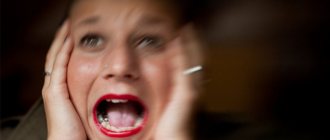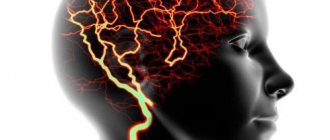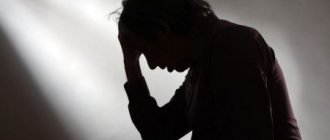Symptoms of anxiety-depressive disorder
Anxiety-depressive syndrome primarily includes signs of depression, manifested in the classic version by a triad of symptoms, which are the main criteria for diagnosing depression in ICD-10:
- Hypotymia is a decreased background mood, accompanied by a feeling of melancholy. It is described as an excruciating sensation in the body, localized behind the sternum (“mental pain”). The affect of melancholy affects all mental, productive activities of the patient. Ideas of self-blame for failures in life, “viciousness” appear; nothing makes you happy. Sensual delusions may occur: the patient is convinced of his own “immortality” and doomed to “eternal suffering” (Cotard’s delusion). Suicidal thoughts are especially dangerous.
- Anhedonia is a condition in which the ability to derive pleasure from previously pleasurable things is lost.
- Anergy. It manifests itself as a state of severe fatigue that does not go away even with prolonged rest. With a more pronounced degree of depression, it manifests itself as ideational and motor retardation, in which there is a feeling of a slow flow of thoughts, apathy, a slow gait and a stooped, hunched posture. In an extremely severe degree, inhibition can reach the level of depressive stupor: a person lies in one position for a long time, staring at one point, does not talk, does not eat or drink
In addition to the triad of main symptoms, depression is characterized by a variety of other manifestations that determine the severity of the disease:
- “Mental anesthesia” is a painful “numbness of the senses.” It manifests itself as a feeling of incompleteness of experiencing feelings.
- Sleep disturbance. Depression is characterized by early awakening, after which it is impossible to fall asleep again.
- Loss of appetite. Most often, there is a decrease in appetite up to a complete refusal to eat, which leads to significant weight loss. Increased appetite appears less frequently.
- Pronounced feelings of guilt up to delirium of self-blame. A person begins to blame himself for everything that happens not only to him, but also to others, sometimes strangers.
- Suicidal intentions. A person may express thoughts of suicide and even make attempts.
Depression is often accompanied by anxiety, forming a mixed anxious-depressive state. In this case, symptoms of anxiety are layered: nervous tension, uncertain anticipation of negative events, misfortunes. The consciousness of patients in a state of anxious depression is filled with fears about the future: anxiety about health (their own or loved ones), financial and social well-being, etc.
Depression, accompanied by severe anxiety about one’s health, is isolated separately and called hypochondriacal.
Sometimes depressive motor retardation with anxious depression is replaced by attacks of motor and emotional excitement - anxious agitation. At the same time, the person becomes extremely fussy, cannot sit in one place, and is only able to perform automatic actions. The attack is accompanied by an acute, unbearable feeling of despair.
Autonomic symptoms
Anxious depression is often accompanied by autonomic symptoms (excitation syndrome of the autonomic nervous system). Patients experience attacks of palpitations, lability (regular spontaneous increase in values) of blood pressure, headaches, shortness of breath, disorders of the digestive system, and in women - dysmenorrhea (severe pain in the lower abdomen during menstruation).
Patients are often bothered by unpleasant or painful sensations in internal organs or parts of the body (psychosomatic symptoms), but the most detailed examination fails to detect any organic pathology. These sensations can be persistent, cannot be relieved by any medications, and thereby increase hypochondriacal anxiety.
In some cases, vegetative and hypochondriacal symptoms completely mask the symptoms of depression. This pathology is called larved or masked depression. These patients are particularly difficult to diagnose.
Causes
Depressive disorder syndrome manifests itself differently in each patient, making it difficult to name the exact causes. Among the main, general ones, it is necessary to highlight:
- genetic predisposition;
- development of pathologies leading to nervous disorders;
- unstable psyche;
- frequent stress.
The manifestation of any symptoms is typical in the morning or at night. Morning or night is perceived by the patient as a hopeless, anxious time of day. As practice shows, it is during this period that suicides most often occur. But not only activity is characteristic of this time, the patient may show complete absence, indifference, indifference to everything that happens around, apathy.
Anxiety versus depression
Anxiety-depression implies a combination and complex relationship between two different conditions - anxiety and depression. It is difficult to determine unambiguously which of them predominates, since they can transform into each other and be replaced. For example, anxiety may increase against the background of depression, and after a phase of intense anxiety, a depressive state occurs.
Since fear is observed in an anxious state, a person loses the ability to think adequately and soberly: he sees a threat everywhere, because of this, a person develops a depressed state, anhedonia (inability to rejoice).
This naturally leads to depression.
Since fear in this mental disorder does not have an objective cause and therefore does not find a way out, it paralyzes a person’s actions. A person experiences fear, but does nothing, because there is no threat, there is no need to run and save himself, there is no need to defend himself.
During anxiety, the release of stress hormones (adrenaline, norepinephrine, cortisol) into the blood increases, which excite the nervous system. The production of “happiness hormones” - serotonin and dopamine - is also inhibited.
What it is
Anxiety and depressive disorders are phenomena of different origins. Despite their differences, they often accompany each other like smoke and fire. To understand the nature of the syndrome, you need to understand its components.
Depression is a mental disorder of the emotional and volitional sphere. It is manifested by pathologically depressed mood, lack of will and reduced motor activity.
Depression has been called the common cold of the 21st century and is the most common mental disorder. Every tenth person over 40 years of age suffers from it. Women are more susceptible to depression. Pathology is diagnosed in young men with a frequency of 15% to 40%.
Anxiety is internal tension, a feeling of discomfort. Anxiety is accompanied by the expectation of troubles in the future and non-acceptance of the “here and now” position - patients think about the future as a pessimistic reality in which unpleasant events await them.
The essence of anxiety is that there is actually no real reason to worry. However, due to incorrect perception and failure of chemical processes in the brain, a person expects events, the probability of which in reality tends to zero.
Causes of anxiety and depressive disorders
Despite the fact that there are causes and provoking factors, sometimes anxiety-depressive disorder occurs on its own, without apparent objective reasons. In this case, there is concern about the presence of another mental disorder.
The main causes of anxious depression are:
- intense short-term stress or constant chronic stress;
- excessive physical and mental feelings of tension;
- the presence of similar disorders in family members;
- long-term, serious illness, accompanied by an exhausting fight against it;
- self-medication with psychotropic drugs such as tranquilizers, antipsychotics, antidepressants, anticonvulsants;
- difficult problematic life circumstances (job loss, financial difficulties, family troubles);
- alcohol and drug addiction, depleting the nervous system;
- age-related crises in adolescents, the elderly, women during menopause, people in a “midlife crisis”;
- post-traumatic stress disorder (as a result of war, loss of loved ones and other various disasters).
Depressive asthenic syndrome
This is a form of psycho-emotional disorder characterized by fatigue, decreased performance, apathy and negativism. A distinctive feature is similar manifestations with depression and asthenia. As a result, diagnostic difficulties may arise. In addition, over time, the nervous system becomes completely exhausted.
Speaking about the causes of the disease, it can be noted that, first of all, it manifests itself due to the development of a depressive state. It is characterized by a long period of development, during which it proceeds quite smoothly and does not cause serious psychosomatic abnormalities.
It is important to note that today experts cannot establish the exact causes of the development of depressive asthenic syndrome. It often occurs in people suffering from infectious diseases due to physical overload, use of illegal drugs, psychotropic substances, poor lifestyle choices, and individual characteristics of the body.
Clinical forms
The disease has the following forms:
- endogenous depression (internal causes, lack of joy hormone);
- reactive depression (psychogenic: response to a traumatic event);
- drug-induced depression;
- neurotic anxiety disorder (neurosis);
- panic disorder;
- generalized anxiety disorder (constant anxiety, which creates a feeling that it is not related to specific objects or circumstances);
- agoraphobia without panic disorder;
- obsessive-compulsive disorder;
- social phobia;
- specific phobias;
- post-traumatic stress disorder;
- acute stress disorder.
Panic attack with anxiety disorders
Anxious depression may be accompanied by a sudden feeling of panic called a panic attack. It manifests itself in a sudden feeling of intense fear. This condition is accompanied by various somatic (bodily) symptoms, such as:
- changes in breathing (rapid breathing or holding your breath, shortness of breath, etc.);
- rapid heartbeat;
- discomfort in the heart area;
- increased sweating;
- dizziness, sometimes to the point of loss of consciousness;
- symptoms from the gastrointestinal tract (nausea, vomiting, abdominal pain, constipation, diarrhea, bloating, etc.);
- frequent urination.
These manifestations of the disease can be observed either individually or in combination. In addition, there may be other sensations in the body such as chills, tingling, heat, etc.
Symptoms of the disease
The symptoms of the disease are quite extensive. The main manifestations include:
- Sudden mood swings without any significant reason.
- Depressed state.
- Lack of interest in the outside world.
- Sleep disorders.
- The appearance of unreasonable fear, in advanced cases - panic attacks.
In addition, there are also autonomic dysfunctions of various types. These are cardiac dysfunction, shortness of breath, arrhythmia, indigestion, increased sweating. Such conditions are considered as symptoms if they exist for a certain period of time - from 10 to 14 days.
Diagnostics
Anxious depression is diagnosed taking into account the clinical picture and special methods. Standard methods include:
- Zang scale (test for determining depression);
- Beck Depression Inventory (used to determine the severity of depression);
- Luscher color test - used to analyze the state of the individual and the degree of neurotic disorders, if any;
- Hamilton and Montgomery-Asberg scale - give an idea of the severity of depression.
When assessing the clinical picture for making a diagnosis and choosing treatment methods, the following criteria are taken into account:
- the presence of anxiety and depressive symptoms;
- inappropriate response to a stress factor;
- duration of symptoms (what period exist);
- the conditions under which symptoms occur;
- the need to exclude other diseases of the body.
When to see a doctor
If you experience frequent mood changes, manifestations of depression, apathy, or the development of an inferiority complex, you need to make an appointment with a psychotherapist. JSC “Medicine” (academician Roitberg’s clinic) employs qualified specialists and psychotherapists with extensive experience. Experienced neurologists also work on site at the clinic. JSC "Medicine" (clinic of academician Roitberg) is located in the center of Moscow, at 2nd Tverskoy-Yamskaya lane 10, not far from the metro stations Chekhovskaya, Mayakovskaya, Belorusskaya, Novoslobodskaya, Tverskaya.
Which doctor treats anxious depression?
Symptoms of a psychosomatic disorder are perceived by the patient not as a mental disorder, but as another disease of the body. This happens because a person feels unpleasant painful sensations in the body, but does not know what it is connected with. He begins to think that he has some kind of disease, and visits various specialists (cardiologist, gastroenterologist, pulmonologist, oncologist, endocrinologist, etc.). And this is correct: it is necessary to exclude organic pathologies that may be present in the body.
There is a combination and interrelation of mental disorders and some kind of physical illness. Therefore, such logic and such human actions are justified and correct. However, rarely does anyone think that the cause of the symptoms may be a psychological disorder, and they turn to a psychotherapist after they have visited all possible specialists.
A widespread scenario is when a person goes straight to a regular therapist. The doctor, having not found any diseases, refers the patient to a neurologist (neurologist). The specialist diagnoses vegetative-vascular dystonia and prescribes sedatives and tonics that affect the nervous system.
However, the treatment does not produce significant results, and the neurologist refers the patient to a consultation with a psychiatrist. He prescribes strong medications that relieve symptoms of anxiety and depression. However, when the medication ends, the symptoms return with renewed vigor. Therefore, limiting ourselves to a psychiatrist who treats with drugs is not appropriate here.
A psychotherapist is a specialist who has the necessary knowledge and skills to conduct complex therapy. If, nevertheless, it is not possible to find a psychotherapist, then you can combine the help of different specialists: a psychiatrist and a psychologist. Therefore, it is so important to carry out treatment comprehensively, and a psychotherapist is best able to cope with this task.
Features of treatment
Fear of snakes - what kind of disorder is it?
Treating diseases is not so easy, since it is necessary to eliminate the cause of the problem. Therefore, a combination of drug therapy and psychotherapy is used.
For diagnosis, an interview is conducted and the patient is asked to fill out the HADS Depression and Anxiety Scale. This is usually enough to make a diagnosis. It is advisable to undergo examination by an endocrinologist - this is necessary to identify problems of an organic nature.
Medical treatment
Several groups of medications are used to relieve symptoms. First of all, these are tranquilizers. Such remedies are useful for relieving tension, panic, and aggression.
Antidepressants are aimed at stabilizing the emotional state
In case of inadequate reactions, antipsychotics are prescribed. They affect a specific area of the brain. Sedatives help normalize sleep, relieve excitability and tension.
Nootropics are used to improve performance. They improve blood circulation and brain function.
Important! Only a psychiatrist can select and adjust drug therapy.
Additionally, alpha- and beta-blockers can be used. They turn off some receptors, increase blood glucose levels and well regulate vegetative manifestations.
Psychotherapeutic methods
Correction of anxiety-depressive disorder is aimed at changing the patient’s lifestyle. Cognitive behavioral therapy uses special techniques that help teach a person to live according to new patterns.
Changing your way of thinking makes you look at life differently. Thanks to him, the patient will learn to perceive his problem as groundless. When he realizes that there is nothing to be afraid of, it will become easier for him. Cognitive behavioral therapy begins to work from the first session.
In hypnosis, a person is put into a trance state. In this form, it is easy to change negative attitudes and incorrect perceptions of the world. A feeling of satisfaction, a great charge of energy and strength appears.
Hypnosis sessions can only be conducted by a specialist, otherwise you can only harm the patient
Art therapy helps to cope with anxiety. Drawing allows you to express emotions on paper, work through them and perceive them differently.
Combination of psychotherapy and pharmacology
In order to successfully treat anxiety-depressive disorder, you need to use complex therapy. You can't stop at just one thing.
Drug therapy should occupy 50% of the treatment, the same part should be psychotherapy. You should not stop treatment halfway, otherwise the symptoms will quickly return.
Important! If side effects occur, you must immediately notify your doctor and change the drug.
Anxiety-depressive disorder is a serious disorder that can lead to irreversible consequences. Therefore, you should not delay starting treatment. If you feel groundless anxiety and low mood, you should immediately contact a psychiatrist. With timely help, the person will return to his usual lifestyle and normalize his condition.
Treatment of anxiety and depression
Drug treatment
The following drugs are prescribed in the treatment of anxiety-depressive syndrome:
- Antidepressants (Prozac, Escitam, Amitriptyline). They are used to correct the content of biologically active substances such as norepinephrine, dopamine, and serotonin in the body. These medications relieve symptoms of depression. Normalization of mood, appetite, sleep and mental activity is observed. The course of treatment is long, since the effect of drugs does not occur immediately, but as they accumulate in the body and adapt to them. Antidepressants must be selected individually for each patient.
- Tranquilizers (Phenazepam, Gidazepam, Elzepam, Seduxen, Elenium). Effectively eliminate the anxiety component, panic attacks and psychosomatic manifestations. Drugs in this group have muscle relaxant, anticonvulsant and vegetative stabilizing effects. The effect appears quickly, but can end just as quickly. Tranquilizers in tablet form have a longer lasting effect because they act more slowly. This group of drugs is quickly addictive, so treatment courses are short.
- Typical (truxal, haloperidol) and atypical (eglonil, teraligen, quetiapine) antipsychotics. Typical antipsychotics are used less frequently. Some antipsychotics have a moderate antidepressant effect due to partial blocking of serotonin receptors, as a result of which the “happiness hormone” accumulates. Neuroleptics also have a significant anti-anxiety effect. The advantage of drugs in this group is that they are practically non-addictive, which makes it possible to take them for a long time.
- Beta-blockers (Anaprilin, Atenolol, Metoprolol). Prescribed in case of a combination of anxiety-depressive disorder with vegetative-vascular dystonia disorders. Drugs in this group normalize blood pressure, treat arrhythmias, and eliminate unpleasant sensations such as fever, chills, tremor and other vegetative symptoms.
It is necessary to strictly observe the permissible dose of the drug, the time of administration, avoid drinking alcohol and do not drive a car during treatment. Only a psychiatrist has the right to prescribe drugs from these groups. When reading the instructions for medications, pay attention to the point “interaction of the drug with other substances.”
Physiotherapy methods
Physiotherapy is an effective method in the complex treatment of psychosomatic disorders:
- massage (manual and electric);
- electrosleep;
- electroconvulsive therapy;
- acupuncture;
- water treatment procedures.
These procedures have calming, relaxing, tonic, stimulating effects, normalize the activity of the nervous and cardiovascular systems and brain function.
Psychotherapeutic methods
The following treatment methods are used in psychotherapy:
- rational belief;
- mastering methods of meditation and relaxation;
- conversations with a psychotherapist.
Traditional treatment
Herbal medicine has proven itself well for anxiety depression. Most often, herbal infusion of St. John's wort is used in treatment. Tinctures of ginseng, motherwort, hawthorn, valerian, lemongrass, Rhodiola rosea and other plants are also used.
Nutrition
Nutrition should be rational and organically balanced with all vital substances. It is important to follow the correct diet with meals at the same time, in the required volumes.
The food taken should be fresh, if possible with a minimum amount of harmful additives, sufficiently thermally processed (if necessary) and pleasant in taste, smell and appearance.
The importance of professional help
A person encountering TDS for the first time does not understand the seriousness of this illness and perceives it as simply a bad mood. But depression is a syndrome that includes many symptoms and biological changes, including in the brain. This disease makes it so that the patient is unable to do anything to improve his condition. Therefore, it is extremely important to seek help from a professional.
Without treatment, the disease can only progress; it develops for about two years and develops into a chronic form that can last a lifetime and cannot be treated. If treatment is started on time, the symptoms may subside within three weeks.
Anxiety-depressive syndrome is a disease that has recently become more common among young people. The emergence and spread of this disease raised the question of the need to master mental hygiene. We must learn to control our emotions and experiences, give them a way out using relaxation techniques. You need to be able to think positively in order to prevent the disease from developing. Hard work and drug treatment will give positive results, the main thing is to make the correct diagnosis in time.
Disease prevention
A person who is mentally resistant to the outside world:
● tries not to get hung up on emotions that cause unpleasant sensations and learns to switch to positive ones;
● refuses alcohol, nicotine, eats healthy food and engages in sports that interest him;
● does not overwork mentally and physically;
● gets enough sleep;
● expands the “comfort zone” (travels, learns new things, meets people);
● attends various hobby groups (a favorite hobby helps to repress anxious thoughts and minimizes the chances of depression).
Drug therapy
Antidepressants such as Imipramine, Prozac and Amitriptyline have a beneficial effect on the levels of dopamine, norepinephrine and serotonin in nerve cells. The above drugs help improve the patient’s condition (increase mood, reduce feelings of anxiety, apathy, emotional instability, sleep and appetite return to normal). A long course of treatment with antidepressants is explained by the fact that their substances must accumulate in the body. Therefore, tranquilizers often need to be taken along with them. Their effect appears after 15 minutes. The doctor selects antidepressants for each patient individually and prescribes a course of treatment that must be strictly adhered to. These drugs are not addictive.
"Seduxen", "Elzepam" and "Phenazepam" are tranquilizers that successfully fight panic attacks, anxiety and emotional stress. The effect of the drugs is noticeable almost immediately and lasts for several hours. Injections give even faster results, but the effect disappears just as quickly. Tranquilizers are addictive, so the course of treatment is quite short.
If this emotional disorder is complicated by autonomic dysfunction, the patient is prescribed beta-blockers. They restrain vegetative-vascular symptoms, namely sweating, fever, tremors, weakness, increased heart rate and blood pressure. Beta-blockers include drugs such as Atenolone, Anaprilin, Betaxolol and Metoprolol.










